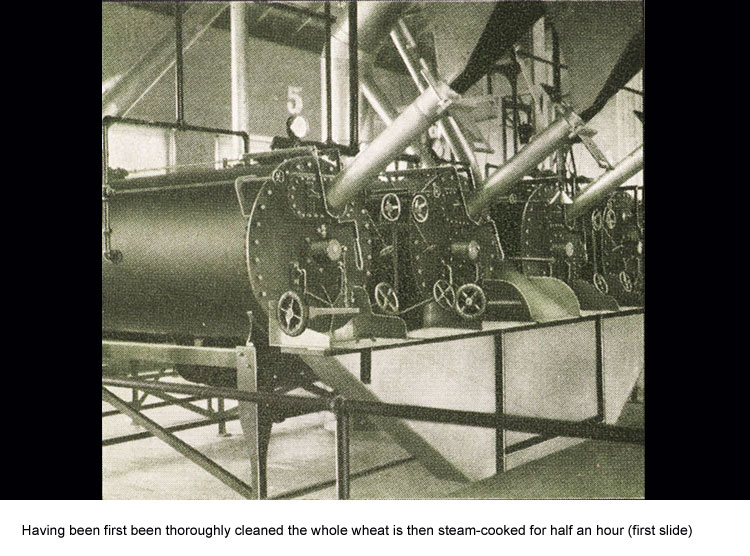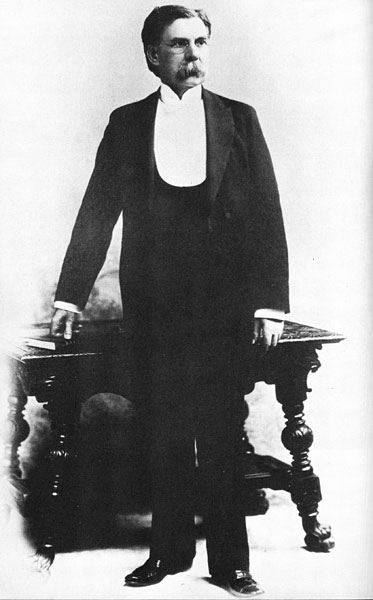 Henry Perky, founder of the Natural Food Company and inventor of the shredded wheat biscuit. Image source: "Out of the Cracker Barrel"
Henry Perky, founder of the Natural Food Company and inventor of the shredded wheat biscuit. Image source: "Out of the Cracker Barrel"
Henry Drushel Perky was 58 years old when he came to Niagara Falls in 1901 to construct his Natural Food Company factory. He had already had a multifacted career in several parts of the U.S.; he had been a school teacher, a lawyer, Nebraska state senator, built the Denver Central Railroad, invented the steel railroad car.
Then in 1890, he had invented a breakfast cereal made from whole what kernels that, after steaming, were pressed through two rollers, one of which had fine grooves, creating a stream of shreds. When layered and cut into 3" x 4" biscuits, they were toasted and tasted very good to him and to those to whom he gave samples. Perky was more than an inventor, however; like cereals by Kellogg and Post, his product was but a part of a larger healthy-eating-through-natural-food movement that introduced the ready-to-eat cereal industry to Americans. Perky intensively marketed his shredded wheat biscuit, emphasizing that whole wheat had restored his own health.
From a factory in Boston in 1894, he moved to a larger factory in Worcester, Massachusetts in 1895, the same year the Niagara Falls Power Company began generating electricity in Niagara Falls from the Niagara River. The young power company began to actively recruit companies to locate in Niagara Falls in order to sell them the company's electricity. Within a year or two, Henry Perky was leading Niagara Power executives through his Natural Food Company factory in Massachusetts.
The power company owned a large industrial tract of land in Niagara Falls and offered Perky a site on which to build a new factory. But Perky was unwilling to locate his shredded wheat factory in the midst of the dirty industry already there, and so he selected a location bounded by the Niagara reservation, Buffalo Avenue, 4th and 6th streets, ten acres in all. It was a residential neighborhood, far from the sooty, noisome industries.
To fund the enormous factory complex he envisioned, Perky entered into a financial arrangement that would offer $10 million dollars in stocks to investors.Two of the first directors, William B. Rankine and Darius O. Mills, were part of the Niagara Power Company. The Natural Food Company would eventually contract for the purchase of 2500 HP of electricity.

View from the roof garden atop the Natural Food Company building, showing the residential neighborhood in which it was built.
The residents of Niagara Falls were of two minds initially when they learned of this new factory. Some were ecstatic about the new investment, part of a major influx of industry that was attracted to the electrical power. Others objected to Perky's choice of factory location, a beautiful residential neighborhood with a view of the Niagara rapids. Demolished for the factory was the 1859 Peter A. Porter family homestead at the corner of Buffalo Avenue and 4th Street, as well as the homes of George M. Porter, Miss Townsened, and Mrs. E.P. Church.
Perky engaged Worcester architects Earl & Fisher to design his "Palace of Light," as he termed his steel-framed factory with 844 windows. His conception of a factory as a pleasant place for workers put him in the top tier of industrial builders of his time. He engaged the Olmsted brothers of Boston to lay out grounds around the factory complex in order to promote better urban life for workers and city residents.The grounds, with landscaped paths, winding drives, playground, tennis court, ball diamond and plots for employee gardens, were decades ahead of American corporate thinking of the time.
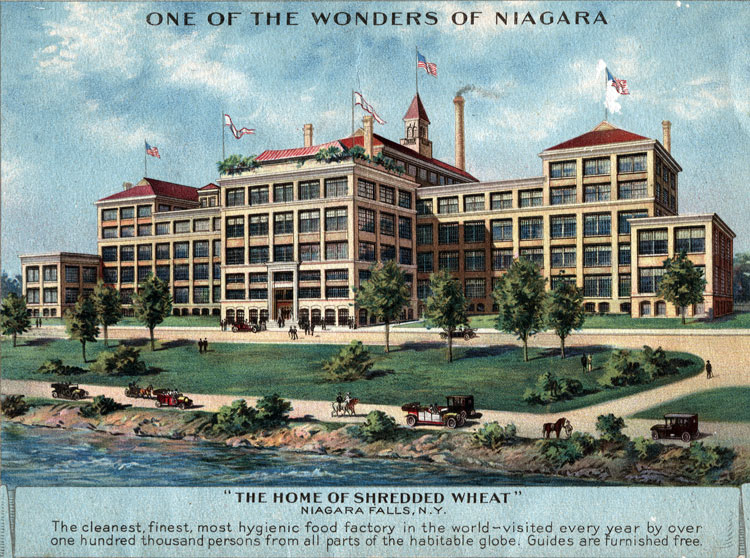
Color illustration of the Natural Food Company complex, 430 Buffalo Avenue. Image source:private collection
The factory complex consisted of a five-story factory where the shredded wheat (and Triscuits) were made and packaged, with a four-story administration building in front where office work was done, employee perks utiilized, and visitors accommodated. In all, with 4 million bricks, 200 tons of marble, 30,000 panes of glass, the Natural Food Conservatory, as Perky called it, cost $2,000,000 to construct. And its opening was timed to coincide with the Pan-American Exposition in 1901. The first shredded wheat biscuits rolled off the line on May 15, 1901. Perky marketed his product and factory tours to Exposition visitors in Buffalo.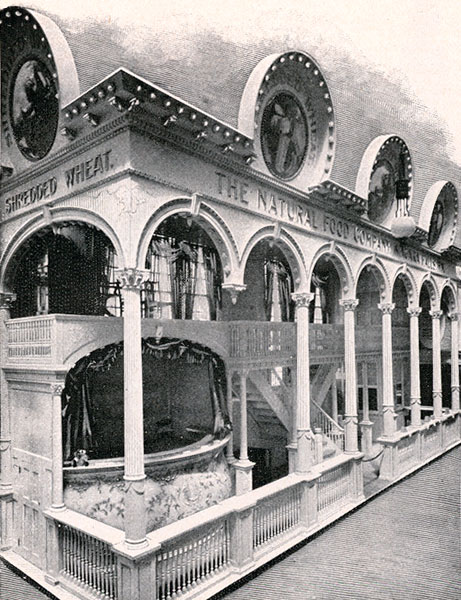
The Natural Food Company's booth in the Manufactures and Liberal Arts building at the Pan-American Exposition, Buffalo 1901. Image source: private collection.
From the Buffalo Courier, July 21, 1901:
"Just a dim reflection of some of the workings of the Natural Food Company may be had by visiting the Pan-American Exposition where, in the northeast corner of the Manufactures and Liberal Arts Building, is the company's booth.
"Creamy white is its chief color decorations with pale green, and here and there a faintly tinted shade of pink, blending into the whole scheme and casting about the entire booth a display of colors that in itself attracts immediate attention...
"A railing skirts its outer edges and at well chosen places from this great pillars rise to the topmost points of the roof. Shelves fill the space between the columns, and upon them the Shredded Wheat products are attractively displayed for the attention of the passing multitudes.
"On the lower floor of the booth is the demonstration and display department and like everything that characterizes Mr. Perky's great establishment, the whole design of these is unique and interesting.
"Over at the right a model kitchen with an electric range furnishes a place where daintily dressed and skillful cooks prepare Shredded Wheat into dishes that send forth tempting odors and arouse the interest of food epicures...
"At the left of the booth is the Theatorium, which is a tasty little stage with scenic effects and a real entertainment in operation..."
Use the controls beneath each image to move back and forward.
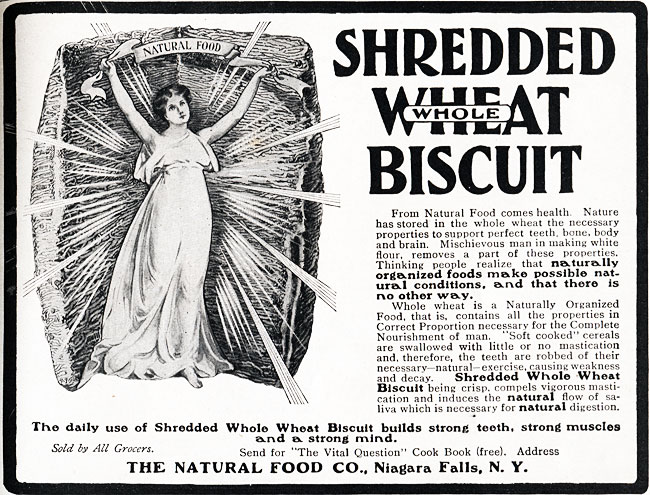
Advertisement from 1902 magazine. Image source: private collection
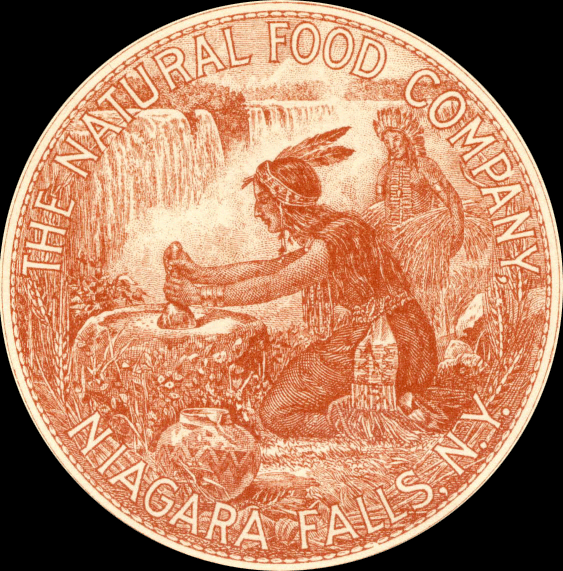
Company seal, designed by Raphael Beck, 1901.
Image credit: Niagara Falls Public Library, Local History Department
The Daily Cataract-Journal, January 22, 1901: "Raphael Beck Gets Perky $100 Prize. Henry D. Perky announced today at noon that the prize of $100 which he offered some time ago for the best design for the seal for the Natural Food Company had been awarded to Raphael Beck of Lockport, the designer of many of the most successful Pan-American emblems. The award was made by eight students of the Oread Institute of Worcester and the principal. There were a number of designs submitted but it was unanimously agreed that Mr. Beck's surpassed them all. His proposed seal represents an Indian girl preparing flour in one of the vessels used by the Indians. It represents strikingly the motto of the Natural Food Conservatory in that it shows flour being made from the whole wheat."

Company promotional card linking Niagara Falls with shredded wheat. Image source: private collection.
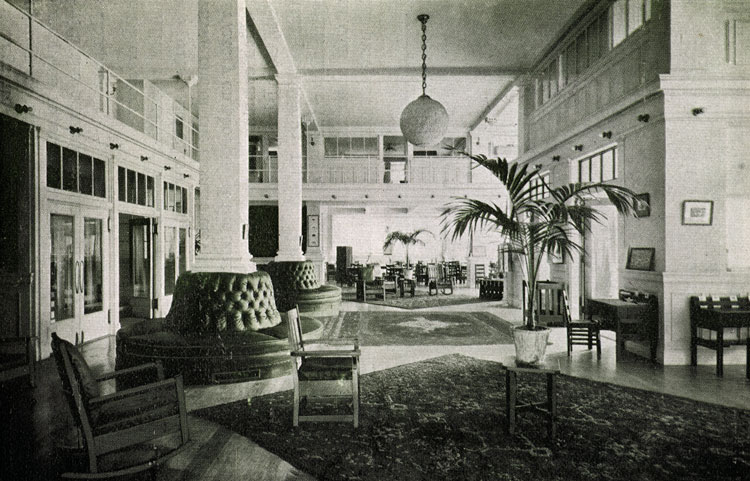
Lobby of the Administration Building.
Like a handful of other manufacturers, including the Larkin Company, Perky believed that he could best acquire new adherents to his shredded wheat products and his philosophy of health with factory tours. Until discontinued sometime around 1946, tours of the shredded wheat factory were part of the marketing of Niagara Falls. Honeymooners saw the falls and then toured the factory. The company estimated that around 100,000 visitors took the tour annually. Perky had designed the factory with balconies and aisles that permitted visitors to see the machinery in operation. They were welcomed every day of the week all year except Sundays, in the lobby above, fitted to resemble that of a hotel. Off to one side was a demonstration area where free lunches were served to visitors that used shredded wheat products in various ways. Tour guides led the visitors through the 5.5 acre factory and up to the roof garden and auditorium where they heard lectures on diet, cooking and good living.
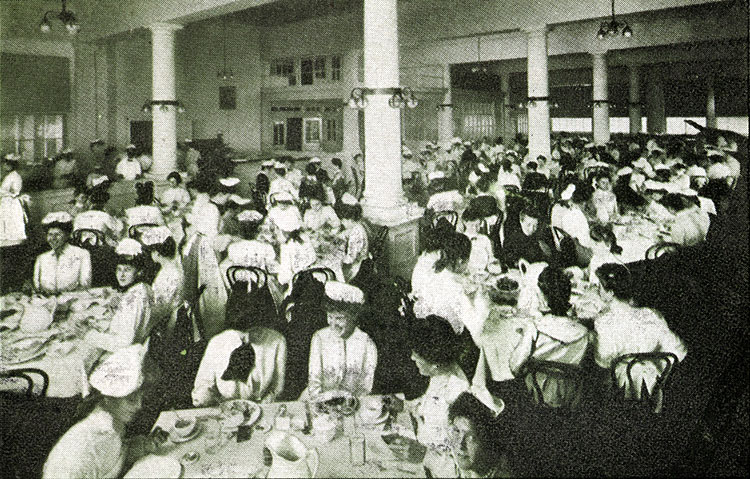
Lunchroom for female employees
For much of its history in Niagara Falls, the factory employed around 500 workers (850 in 1941). Perky's philosophy of worker welfare led to extensive employee benefits. Each employee had a locker to use for changing; there were 13 showers and 13 bathtubs (with free soap and towels) which employees could use for an hour each week on company time. The company boasted that its marble and mosaic bathroom facilities cost $100,000. Men and women had separate lunch rooms; lunches for women were free of charge, men paid $.10 for theirs. A sample employee lunch was: vegetable soup, shredded wheat toast, beef cutlets, baked potatoes, beet salad, Boston brown bread, Charlotte pudding, coffee.

Library reading room for employees
Each employee had a 15-minute break in the morning and afternoon in addition to an hour for lunch. Employees were encouraged to use the lending library. Classes were offered in shorthand, typing, math. There were etiquette classes, dancing classes, choral singing, instruction in musical instruments, and various clubs, all offered on company time. Employees were even paid if they chose to attend a summer outing in the country. All of these were intended to encourage teamwork and positive attitudes toward their work.
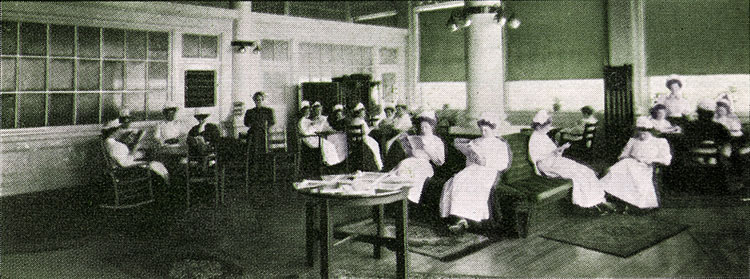
"Rest room" for female employees, with games and puzzles.

800-1,000 Seat auditorium in the administration building.
The auditorium was used periodically for employee lectures and entertainments, but was also offered to outside groups at no charge. Niagara Falls was a convention city and this facility was excellent advertising for the company. In October, 1910, the New York State Woman Suffrage Assocation held its meetings in the auditorium above.
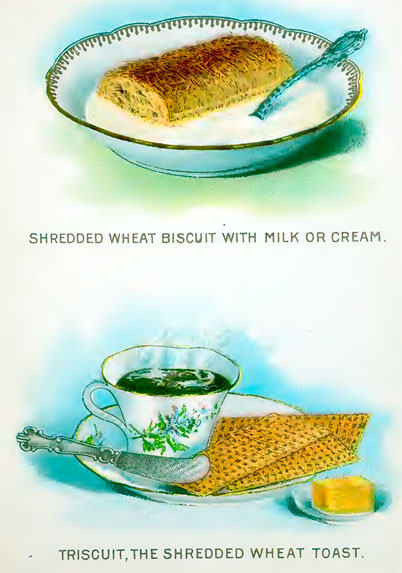
Page from promotional booklet showing The Natural Food Company's two products,1914.
Henry Perky's association with the Natural Food Conservatory was unfortunately short-lived. A year after opening the new factory, he announced plans to construct a second Oread Institute, identical to the one he built in Worcester to instruct young women in the domestic sciences and promote his healthful philosophies. He engaged Esenwein & Johnson to draw up the plans. And then, suddenly, in July 1904, newspapers announced his resignation as president of The Natural Food Company. The board of directors replaced him with William Hamlin. Perky's impulsive personality, his vision of a health food product inseparable from the philosophy he promoted, likely combined to prompt his board of directors to shift the company's focus to a more profit-oriented direction. Perky sold his stock in the Niagara Falls company and moved to Glencoe, Maryland where he bought land for construction of another Oread Institute, this one for young men. His health deteriorated, however, and he died in 1906, a month after a fall from a horse on his farm.
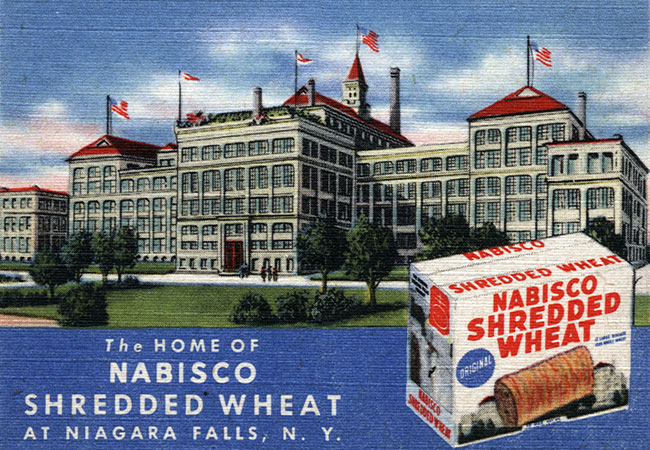
Part of a postcard showing Nabisco's continuing linkage of the Niagara Falls factory with shredded wheat. Image source: private collection
The story of shredded wheat in Niagara Falls had just begun, however. The company renamed itself the Shredded Wheat Company in 1908 and began putting an image of Niagara Falls on its cartons in 1910, forever linking both in the minds of American customer and greatly increasing sales. In 1908, a second plant opened in Niagara Falls, Ontario. In 1914, the company expanded with new warehouse facilities served by railroad tracks on Rainbow Boulevard. It was expanded in 1921. More plants were opened in the U.S. and England and, in 1928, the Shredded Wheat Company was sold to Nabisco and renamed "National Biscuit Shredded Wheat" (1933) and finally, "Nabisco Shredded Wheat" (1941).
In 1954, the Rainbow Boulevard site began production of shredded wheat as Nabisco offered the old factory and administration building for sale. In 1956, the administration building closed and was leased to Union Carbide as a research facility. In 1963, that building became the first home of Niagara County Community College, which locals called "Nabisco Tech." That same year, the old factory building was demolished.

Bing aerial view, present. The red rectangle at left is the location of the old Shredded Wheat factory. The blue area at right is
the later expansion.
By 1973, when NCCC moved to its permanent campus in Sanborn, the old administration building was in danger of being demolished, possibly for a hotel. Local preservation-minded citizens succeeded in having it added to the National Register of Historic Places the next year. It was demolished in 1976; the site remains vacant in 2014.
In 1992, production of shredded wheat in Niagara Falls (U.S.) ended; the factory continued to make Triscuits. The next year, Kraft-General Foods bought all shredded wheat production, leaving Nabisco with Triscuits. And then in 2000, Kraft purchased all of Nabisco and shut down the Rainbow Boulevard factory on December 13, 2001, one hundred years and seven months almost to the day from the beginning of the Natural Food Company in Niagara Falls. Two hundred workers lost their jobs. Many remembered the scent of hay in the factory and how cool and clean the working environment was. In 2014, the vacant Rainbow Boulevard Nabisco factory is owned by Niagara Falls Redevelopment.
Special thanks to Cecilia Driscoll, local history librarian at the Niagara Falls Library, for her extra efforts to locate the company seal designed by Raphael Beck. She discovered it on a piece of company stationery in the library archives.
